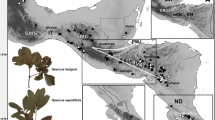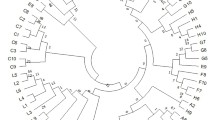Abstract
Conservation of 16 nuclear microsatellite loci, originally developed for Quercus macrocarpa (section Albae), Q. petraea, Q. robur (section Robur), and Q. myrsinifolia, (subgenus Cyclobalanopsis) was tested in a Q. infectoria ssp. veneris population from Cyprus. All loci could be amplified successfully and displayed allele size and diversity patterns that match those of oak species belonging to the section Robur. At least in one case, limited amplification and high levels of homozygosity support the occurrence of “null alleles” caused by a possible mutation in the highly conserved primer areas, thus hindering PCR. The sampled population exhibited high levels of diversity despite the very limited distribution of this species in Cyprus and extended population fragmentation. Allele sizes of Q. infectoria at locus QpZAG9 partially match those of Q. alnifolia and Q. coccifera from neighboring populations. However, sequencing showed homoplasy, excluding a case of interspecific introgression with the latter, phylogenetically remote species. Q. infectoria ssp. veneris sequences at this locus were concordant to those of other species of section Robur, while sequences of Quercus alnifolia and Quercus coccifera were almost identical to Q. cerris.


Similar content being viewed by others
References
Axelrod DI. Biogeography of oaks in the Arcto-Tertiary province. Ann Missouri Bot Gard. 1983;70:629–57.
Barbéro M, Quézel P. Contribution à l’ étude des groupements forestiers de Chypre. Doc phytosociologiques. 1979;IV:9–34.
Barreneche T, Bodenes C, et al. A genetic linkage map of Quercus robur L. (pedunculate oak) based on RAPD, SCAR, microsatellite, minisatellite, isozyme and 5S rDNA markers. Theor Appl Gen. 1998;97:1090–103.
Boavida LC, Silva JP, et al. Sexual reproduction in the cork oak (Quercus suber L). II. Crossing intra- and interspecific barriers. Sex Pl Reprod. 2001;14:143–52.
Camus A. Les chênes. Paris: Lechevallier; 1938.
Christou A (2000). Cyprus, Country Report. Presented in EUFORGEN Mediterranean Oak Network, Antalya 12–14 October 2000.
Curtu AL, Finkeldey R, et al. Comparative sequencing of a microsatellite locus reveals size homoplasy within and between European oak species (Quercus spp.). Plant Mol Biol Report. 2004;22:339–46.
Dow BD, Ashley MV, Howe HR. Characterization of highly variable (GA/CT)n microsatellites in the bur oak, Quercus macrocarpa. Theor Appl Genet. 1995;91:137–41.
Dumolin S, Demesure B, Petit RJ. Inheritance of chloroplast and mitochondrial genomes in pedunculate oak investigated with an efficient PCR method. Theor Appl Genet. 1995;91:1253–76.
Hornero J, Gallego FJ, et al. Testing the conservation of Quercus spp. microsatellites in the cork oak, Q. suber L. Silvae Genetica. 2001;50:162–7.
Isagi Y, Suhandono S. PCR primers amplifying microsatellite loci of Quercus myrsinifolia Blume and their conservation between oak species. Mol Ecol. 1997;6:897–9.
Kampfer S, Lexer C, et al. Characterization of (GA)n microsatellite loci from Quercus robur. Hereditas. 1998;129:183–6.
Krüssmann G. Handbuch der Laubgehölze. Berlin: Paul Parey; 1978.
Manos PS, Doyle JJ, et al. Phylogeny, biogeography, and processes of molecular differentiation in Quercus subgenus Quercus (Fagaceae). Mol Phylogenet Evol. 1999;12:333–49.
Meikle RD. Flora of Cyprus. London: Bentham Moxon Trust, Royal Botanic Gardens; 1977.
Meikle RD. Flora of Cyprus. London: Bentham Moxon Trust, Royal Botanic Gardens; 1985.
Nimri LF, Meqdam MM, et al. Antibacterial activity of Jordanian medicinal plants. Pharm Biol. 1999;37:196–201.
Schirone B, Spada F (2000). Some remarks on the conservation of genetic resources of Meditderranean oaks. Presented in EUFORGEN—Mediterranean Oaks Network, Antalya 12–14 October 2000.
Schwarz O. Entwurf einem naturlichen system der Culpuliferen und der Gattung Quercus L. Notizbl Bot Gart Berlin. 1936;13:1–22.
Schwarz, O. Quercus L. In: Tutin TG, Burger VH, Valentine DH, Walters SM, Webb DA, editors. Flora Europea, vol. I, 2nd ed. Cambridge, UK: Cambridge University Press; 1993.
Scotti-Saintagne C, Mariette S, et al. Genome scanning for interspecific differentiation between two closely related oak species [Quercus robur L. and Q petraea (Matt.) Liebl.]. Genetics. 2004;168:1615–26.
Soto A, Lorenz Z, et al. Nuclear microsatellite markers for the identification of Quercus ilex L. and Q. suber L. hybrids. Silvae Genetica. 2003;52:63–6.
Steinkellner H, Lexer C, et al. Conservation of (GA)(n) microsatellite loci between Quercus species. Mol Ecol. 1997a;6:1189–94.
Steinkellner H, Fluch S, et al. Identification and characterization of (GA/CT)n-microsatellite loci from Quercus petraea. Pl Mol Biol. 1997b;33:1093–6.
Vornam B, Decarli N, et al. Spatial distribution of genetic variation in a natural beech stand (Fagus sylvatica L.) based on microsatellite markers. Conserv Gen. 2004;5:561–70.
Yeh, F. Boyle, TJB et al. Population genetic analysis of co-dominant and dominant markers and quantitative traits. Belg J Bot. 1997;129:157.
Zhou ZK. Origin, phylogeny and dispersal of Quercus from China. Acta Bot Yunnanica. 1992;14:227–36.
Zohary M. Geobotanical foundations of the Middle East. Stuttgart: Gustav Fischer; 1973.
Acknowledgments
We are grateful to Constantinos Kounnamas and Costas Kadis for their advice and assistance during planning and carrying out the collections. This research was conducted in partial fulfilment for the degree of the Albert-Ludwigs University of Freiburg regarding the senior author.
Author information
Authors and Affiliations
Corresponding author
Rights and permissions
About this article
Cite this article
Neophytou, C., Dounavi, A. & Aravanopoulos, F.A. Conservation of Nuclear SSR Loci Reveals High Affinity of Quercus infectoria ssp. veneris A. Kern (Fagaceae) to Section Robur . Plant Mol Biol Rep 26, 133–141 (2008). https://doi.org/10.1007/s11105-008-0025-8
Published:
Issue Date:
DOI: https://doi.org/10.1007/s11105-008-0025-8




